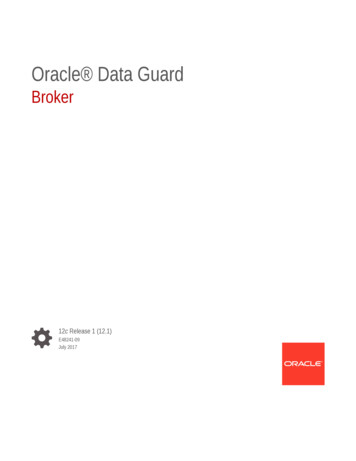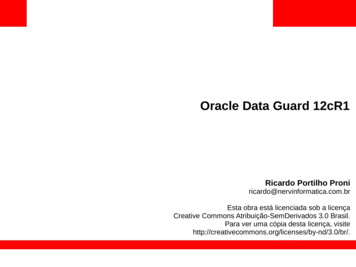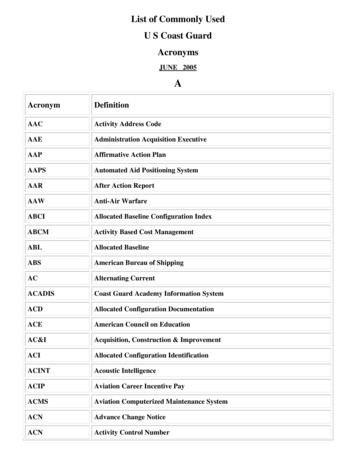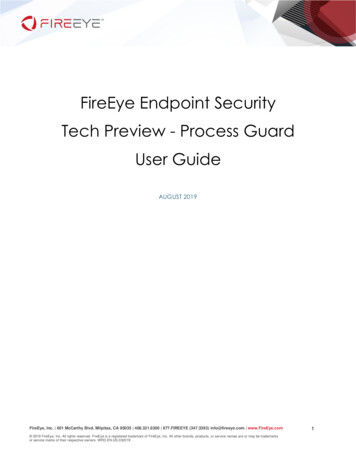
Transcription
Qualcomm Snapdragon, Qualcomm Trusted Execution Environment, Qualcomm Secure StorageSolutions, Qualcomm Secure Processing Unit, Qualcomm Secure File System, and Qualcomm FastTrusted Storage are products of Qualcomm Technologies, Inc. and/or its subsidiaries.Qualcomm and Snapdragon are trademarks of Qualcomm Incorporated, registered in the United Statesand other countries. Other products and brand names may be trademarks or registered trademarks oftheir respective owners. The contents of this document are provided on an “as-is” basis withoutwarranty of any kind. Qualcomm Technologies, Inc. specifically disclaims the implied warranties ofmerchantability and fitness for a particular purpose.Qualcomm Technologies, Inc.5775 Morehouse DriveSan Diego, CA 92121U.S.A. 2019 Qualcomm Technologies, Inc. and/or its affiliated companies. All Rights Reserved.
Overview . 1Acronyms . 2Limitation of pure software-based solutions . 3Hardware building blocks . 4Qualcomm Trusted Execution Environment. 4Hardware Crypto Engine . 6Anti-Replay Protection . 6Others . 7Overview . 8Features . 9Overview . 11Features and Limitations . 11Overview . 13Features and Limitations . 14
Data protection is a well-recognized security requirement for mobile devices, feature designers and mobile app developers.As mobile devices evolve into the most important personal computing platform, they have become the major producer,consumer and storage of user’s personal data. The demand to prevent data stored on mobile devices from unauthorizedaccess arises not only from users’ expectations of privacy, but also from legal requirements and the reputation of relatedtechnology providers. In addition to user data, sensitive information stored on mobile devices can also be from devicemanufacturers, app developers, cloud service providers, network carriers, financial institutions and so on. It is of thebusiness interest of the whole mobile ecosystem to provide secure storage on mobile devices.Designing a secure storage scheme is often challenging and error prone. Home-brew secure storage solutions, especiallythose purely based on software mechanisms, are often vulnerable to attacks. To help address this issue, QualcommTechnologies, Inc. (QTI) has integrated several hardware-backed secure storage solutions in its mobile SoC products. Each ofthese solutions are designed with different purposes. Secure File System (SFS). SFS provides an encrypted file system for trusted apps in Qualcomm Trusted ExecutionEnvironment to store data in the flash storage. Data stored in SFS is only decrypted in memory that QualcommTrusted Execution Environment software can access. It provides even stronger data protection than Keymasterbased encryption because the Android system cannot access the plaintext of the SFS data in any state. SFS is usefulin protecting highly security sensitive information such as user’s biometric data and financial accounts. Keys anddata used to protect intellectual property are often stored in SFS as well. Fast Trusted Storage (FTS). FTS provides trusted apps in Qualcomm Trusted Execution Environment with similarencryption service. Compared to SFS, it trades random file access for higher data throughput to the secure storage.FTS does not support rollback protection, hence data that is vulnerable to replay attacks should be stored in SFS. Qualcomm Trusted Execution Environment RPMB driver (Qualcomm Trusted Execution Environment STOR). RPMB(Rollback Protection Memory Block) is a write protected region on certain flash devices such as eMMC and UFS.Once initialized, this region can only be accessed by trusted apps in Qualcomm Trusted Execution Environmentthrough the Qualcomm Trusted Execution Environment RPMB driver. It is mainly used for storing counters fordetecting replay attacks.1
Android Keymaster[1] for cryptographic keys management. Android applications and system modules can encryptthe data using keys managed by Keymaster or utilize Android file encryption features. Keymaster enforces accesscontrol rules on the use of keys even when the Android system is compromised. For example, if an applicationchooses to protect its data with a key that is only available when the user has unlocked the device, an attackershould not be able to decrypt the data when the device is in locked state even if she has the root privilege of theAndroid system.In the following sections, we show the limitations of software-based secure storage solutions. After brief descriptions of thehardware building blocks used by these solutions, we introduce the architecture and main features of the first three.Android Keymaster deserves a separate deep dive, which will be publishing in the near future.Table 1 in the summary section outlines their differences in usage and features.AESAdvanced Encryption StandardeMMCembedded Multimedia CardFTSFast Trusted StorageGPCEGeneral Purpose Crypto EngineHALHardware Abstraction LayerHMACHashed Message Authentication CodeKDFKey Derivation FunctionICEInline Crypto EngineIMEMInternal MemoryPRNGPseudo Random Number GeneratorREERich Execution EnvironmentRPMBRollback Protection Memory BlockSFSSecure File SystemSHASecure Hash AlgorithmSoCSystem on ChipSPUSecure Processor UnitTATrusted AppTEETrusted Execution EnvironmentUFSUniversal Flash Storage2
As mentioned in the introduction, secure storage solutions purely based on software have certain limitations that weaddress through our hardware-based features. In this section we provide an overview of limitations of software-basedsecure storage solutions. We also discuss hardware building blocks necessary to support secure storage on our SoCs.Secure storage systems that are based on pure software mechanisms lack important hardware security features and,therefore, expose the data to a broader range of threats.Runtime protectionOne common attack on encryption based secure storage is to exploit software vulnerabilities and access keys ordecrypted data directly from the memory. Alternatively, an attacker can inject malicious code or change the executionflow to circumvent access control policies. Either attack allows unauthorized access to keys or data in the memory. Inmany use cases, the device designer or an app developer does not want certain data to be leaked even to a legitimatedevice user, who might root the device to gain full control.To address the above problems, the runtime of the secure storage system needs to be protected from both attackersand users. This is typically achieved by moving the secure storage software to a hardware supported Trusted ExecutionEnvironment (TEE). The solutions described in this white paper are built using such hardware-backed TEEs.Key storageAnother challenge for encryption based secure storage systems is the question where to store the cryptographic keys.No matter how many times the data encryption key is wrapped by other keys, it is vulnerable to reverse engineeringattacks if the outmost key is hard-coded. If the key originates from a cloud service, there is a similar issue of where tostore the secret required to bootstrap the device-cloud communication. Encryption with user credential-derived key isoften vulnerable to brute-force or dictionary attacks and does not protect data which should be invisible to the users.The problem is easier to solve if hardware support is available. One solution is to derive the wrapping key from ahardware key that is unique per device. The key derivation occurs in TEE such that the plaintext of the key doesn’t leak.3
Rollback preventionData encryption software cannot prevent roll-back attacks, which allow an attacker to reinstate a compromised key,downgrade to an older vulnerable software image, or disable access control by resetting the state of the storage. Weneed to utilize hardware to store versions or state values securely.Device bindingAnother related feature that requires hardware support is device binding. It is a critical security feature for securestorage systems, which protects data from a compromised “global” key. Device binding is based on a per-device uniqueidentity which is baked into the hardware and cannot be altered by software after the devices are initialized.All solutions described in this paper are based on device-bound hardware keys.Random number generationSoftware-based pseudo random number generators (PRNG) are dependent on the quality of external entropy source.On their own, they have no entropy and, therefore, lower the effort for cryptoanalysis attacks.The secure storage solutions described in this paper are built on top of the following hardware components: TrustedExecution Environment, Hardware Crypto Engine, and Anti-Replay Protection.Mobile operating systems, such as Android, offer a Rich Execution Environment (REE), providing a hugely extensive andversatile runtime environment. While bringing flexibility and capability, REE leaves devices vulnerable to a wide range ofsecurity threats. The TEE is designed to reside alongside the REE and provide a safe area on the device to protect assets andto execute trusted code.Qualcomm Trusted Execution EnvironmentThe TEE on Qualcomm Technologies SoC is based on ARM TrustZone technology. TrustZone is a set of securityextensions on ARM architecture processors providing a secure virtual processor backed by hardware-based accesscontrol. This secure virtual processor is often referred to as the “secure world”, in comparison to the “non-secureworld”, where REE resides. Software running on TrustZone consists of the Qualcomm Trusted Execution Environmentplatform (Qualcomm Trusted Execution Environment kernel, libraries and services) and Trusted apps. QualcommTrusted Execution Environment provides software support for chipset security and exposes hardware abstraction layer(HAL) APIs for chipset security functions such as crypto, RNG and fuse blocks. Qualcomm Trusted ExecutionEnvironment is also responsible for initializing the system security environment for software and hardware. QualcommTrusted Execution Environment provides security services, such as binary loading, authentication, crypto and logging to4
secure software modules, called Trusted Apps (TAs), which are dynamically loaded and executed in TrustZone. Asshown in Figure 1, transition of execution from the non-secure world to the secure world must be handled by acomponent that runs in secure monitor mode. The monitor component guarantees the context of the secure world tobe segregated from that of the non-secure world.The software running in Qualcomm Trusted Execution Environment is exposed to lower security risks. As part of thesecurity goals, anyone who does not have the device hardware keys must not be able to access Qualcomm TrustedExecution Environment data and services unless they are intentionally exposed. This is supported by variouscountermeasures:1.Qualcomm Trusted Execution Environment is a software framework with a much smaller footprint, and so isthe attack surface.2.TAs running in Qualcomm Trusted Execution Environment must be signed and authenticated when they areloaded. The Qualcomm Trusted Execution Environment platform (including Qualcomm Trusted ExecutionEnvironment kernel and Qualcomm Trusted Execution Environment libraries/services) itself is signed andloaded by the boot loader during the initial device bootup process.3.Separation between TEE and REE is enforced by hardware-based access control. For example, sensitive data ofQualcomm Trusted Execution Environment and TAs are located either on internal memory or an encrypted,integrity protected memory region called Pseudo-IMEM (PIMEM).4.Debug support for Qualcomm Trusted Execution Environment software is separated from that for non-securesoftware.Figure 1: ARM v8 Software architectureSPU5
Qualcomm Secure Processing Unit provides a physically segregated TEE based on a secure processor integrated intosome Qualcomm Technologies SoCs. The Secure Processing Unit (SPU) hardware is a dedicated subsystem that isengineered to provide an independent boot-loader and boot chain, dedicated clocks, hardware-based anti-replayprotection, a key management unit, and a crypto management unit with inline crypto accelerators. Operating conditionsensors are integrated into the subsystem to help prevent power attacks. Its side-channel resistant crypto includesmasking and blinding. SPU is Common Criteria EAL 4 certifiable and designed to meet the security requirements of theAndroid P Strongbox feature.There are two type of hardware crypto engines in Qualcomm Technologies SoCs that contribute to the secure storagesolutions.GPCEQTI General Purpose Crypto Engine (GPCE), also known as the Crypto core, is a FIPS 140-2 certified coprocessor designthat provides hardware acceleration of standard cryptographic algorithms, such as AES and SHA. TrustZone canprogram the Crypto core to provide crypto services to software running both in REE and TEE.One major security gain by using GPCE is that cryptographic operations can use hardware keys from fuse blocks thatnever need to be accessed by software. This is necessary to enable device bound encryption as the device unique keycan only be used on the device. In addition to hardware keys, software key set can be stored in the internal memory ofGPCE. Access to these keys is restricted by access control rules.ICEWhile GPCE provides an acceptable performance, it falls short as the general storage throughput increases. Toovercome performance degradation, another FIPS 140-2 certified hardware crypto engines — the inline crypto engine(ICE) — was introduced on recent Qualcomm Technologies Mobile SoCs to help achieve high throughput cryptographicencryption of storage data. ICE is mainly used by the Android file and disk encryption features.We use hardware mechanisms, such as RPMB, to help prevent replay attacks in the secure storage solutions.RPMB6
The Replay Protected Memory Block (RPMB) is a separated partition on eMMC or UFS devices designed for secure datastorage. Since each access to RPMB must be authenticated, this region is engineered to be write protected fromsoftware entities without the authentication key. This allows the device to defend against rollback or replay attack bystoring versions or counts in this region.Access to RPMB is authenticated by a message authentication code (MAC), which is a hash value generated inQualcomm Trusted Execution Environment from a 256-bit authentication key. This key must be provisioned to theeMMC or UFS device in Qualcomm Trusted Execution Environment before any access to RPMB.In addition to the hardware building blocks described above, Qualcomm Secure Storage Solutions also utilize several otherhardware components such as fuse blocks, the hardware key derivation function (KDF), and the random number generator(RNG).In the following chapters we will describe hardware-backed Qualcomm Secure Storage Solutions, which address theshortcomings of software-based approaches and use the above-mentioned hardware building blocks.7
On Qualcomm Technologies SoCs, runtime protection of sensitive data is provided by Qualcomm Trusted ExecutionEnvironment Secure File System (SFS). It is a file encryption service only available to TAs in Qualcomm Trusted ExecutionEnvironment. SFS can also be used for securing crypto keys, which are designed to be protected from a compromised orrooted Android.In Qualcomm Trusted Execution Environment SFS, data is engineered to be encrypted with AES256-CTR-mode and integrityprotected with HMAC-SHA256. Figure 2 shows the software architecture of Qualcomm Trusted Execution Environment SFS.The SFS API, also known as Persistent Object API, is compliant with GlobalPlatform Device Technology TEE Internal Core APISpecification. It allows Tas to create, enumerate and delete persistent data objects, as well as perform data stream accesssuch as read, write, truncate and seek. Persistent objects are structured into three parts and stored in Android File systemand the RPMB partition: object files which contains sectioned TA data, version, IV for encryption and the HMAC of the file; a per TA Index file which contains metadata (file name and version) of each file; RPMB data which contains SHA256 hash of all indexed data.Since Qualcomm Trusted Execution Environment has no direct access to external storage, there are two Qualcomm TrustedExecution Environment listeners running in REE to proxy SFS access to the physical storage. Listeners are daemons orservices running in Android. They receive requests from Qualcomm Trusted Execution Environment, perform operationsand return the results back to Qualcomm Trusted Execution Environment.8
Figure 2: Qualcomm Trusted Execution Environment Secure File System software architectureQualcomm Trusted Execution Environment SFS has the following security features:Client SandboxingSFS is designed to ensure no TA can decrypt another TA’s files. Keys used for encrypting data of each TA are derivedfrom the hardware key using the TA identifier as the input. The TA identifier is cryptographically bound to the TA binaryand stored in Qualcomm Trusted Execution Environment platform when the TA binary is authenticated. No TA canspoof another TA by crafting the TA identifier.Rollback Protection:A data object has an associated version which can only increase from creation at each modification. These versions arestored within both the data file and the index file. The version and HMAC value of the index file is stored in the RPMB.If an attacker tries to replace a file with an older version, SFS is engineered to detect the version mismatch in thedecrypted data segment and the index file. If the attacker tries to also replace the index file with an old version, SFS candetect the mismatch between the HMAC of the index file and HMAC stored in RPMB.AtomicityAny modification to an SFS file is guaranteed to be an atomic operation. The old data file and index record will not bedeleted until the operation is complete, A dirty flag is set in RPMB during the operation so that SFS can return to a validstate in the event of attacks or a power loss.9
Metadata encryptionData files are stored in segments with fixed length, the file name, version and actual file size can only be found in theindex file, which is also encrypted. Such information cannot be inferred from the Android file system.10
Qualcomm Trusted Execution Environment Fast Trusted Storage (FTS) is an alternative file encr
Data protection is a well-recognized security requirement for mobile devices, feature designers and mobile app developers. As mobile devices evolve into the most important personal computing platform, they have become the major producer, consumer and storage of user’s personal data. The demand to preven











